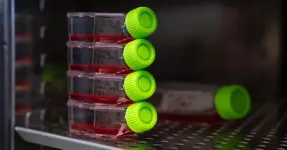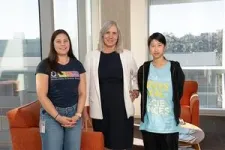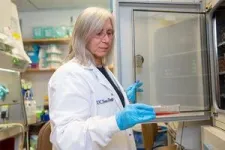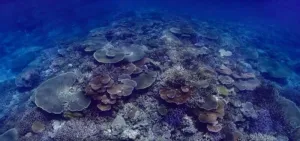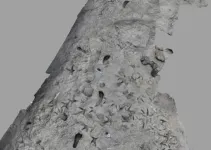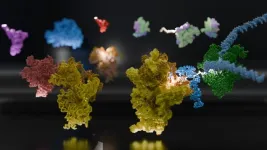(Press-News.org) Researchers at University of California San Diego analyzed the genomes of hundreds of malaria parasites to determine which genetic variants are most likely to confer drug resistance. The findings, published in Science, could help scientists use machine learning to predict antimalarial drug resistance and more effectively prioritize the most promising experimental treatments for further development. The approach could also help predict treatment resistance in other infectious diseases, and even cancer.
“A lot of drug resistance research can only look at one chemical agent at a time, but what we’ve been able to do here is create a roadmap for understanding antimalaria drug resistance across more than a hundred different compounds,” said Elizabeth Winzeler, Ph.D., a professor at UC San Diego Skaggs School of Pharmacy and Pharmaceutical Sciences and the Department of Pediatrics at UC San Diego School of Medicine. “These results will be useful for other diseases as well, because many of the resistant genes we studied are conserved across different species.”
Malaria, a mosquito-borne disease that affects hundreds of millions of people worldwide, is a major public health threat in many tropical and subtropical regions. Despite considerable progress toward controlling the disease, malaria remains a leading cause of morbidity and mortality, particularly in Africa, where 95% of malaria deaths occur according to the World Health Organization. First-line drugs have repeatedly failed due to the spread of drug-resistant strains of Plasmodium falciparum, the parasite that causes malaria.
“The need for new, more effective malaria treatments is urgent, but funding for malaria research and drug development is very limited,” said Winzeler, who in addition to her role at UC San Diego is director of the Bill and Melinda Gates Foundation-funded Malaria Drug Accelerator. “However, the malaria research community is organized and highly collaborative, and our study was able to leverage these strengths to create a resource that will make the process of identifying and prioritizing new malaria treatments significantly easier.”
The researchers analyzed the genomes of 724 malaria parasites evolved in the lab to resist one of 118 different antimalarial compounds, including both established treatments and new experimental agents. By looking for patterns in the mutations that were associated with resistance, the researchers were able to identify unique features of these genetic variants, such as their physical location within genes, that could be used to predict which variations are likely to contribute to drug resistance.
“Our ultimate goal is to use machine learning to help us understand which compounds have the most risk of being compromised by resistance so that we can streamline the early drug development process and ultimately get treatments into clinical trials faster,” said Winzeler. “This study gives us the data needed to train these new tools.”
“The study also uncovers how networks of genes come together to mediate resistance across chemical classes, and provides a road map as we search for resistance-refractory compounds,” adds David Fidock, Ph.D., coauthor and a professor of microbiology and immunology at Columbia University Vagelos College of Physicians and Surgeons.
While the findings have significant implications for the development of new antimalarial drugs, the researchers also highlight that their approach could be relevant across different diseases. This is because the genetic machinery driving drug resistance is consistent across different pathogens and even within human cells. For example, many of the resistance-driving mutations identified in the study were from a protein in P. falciparum parasites, called PfMDR1, that can move substances between various parts of the cell, including transporting drugs away from their site of action. PfMDR1 has an exact counterpart in humans, and mutations in the human version are one of the key drivers of treatment resistance in cancer.
"The potential impact of this study is huge and extends well beyond a single disease,” said Winzeler. "Studying malaria gave us the opportunity to put this resource together, and we hope that these findings will help change the way we study drug resistance as a whole, not just in malaria.”
Link to full study: http://www.science.org/doi/10.1126/science.adk9893
Coauthors on the study include Madeline R. Luth, Karla P. Godinez-Macias, Daisy Chen, Sindhu Daggupati, Jan M. Economy, Juan Carlos Jado, Gregory M. LaMonte, Ashley You, Jair Lage De Siqueira-Neto, Sabine Ottilie and Frances Rocamora at University of California San Diego; John Okombo, Vandana Thathy, Satish K. Dhingra, Sunil K. Narwal, Tolla Ndiaye, Sachel Mok, Tomas Yeo, Heekuk Park, Anne-Catrin Uhlemann, Manu Vanaerschot, and David A. Fidock at Columbia University Irving Medical Center; Xiu Cheng, Tomoyo Sakata-Kato and Nobutaka Kato at Global Health Drug Discovery Institute; Heledd Davies, Rebecca C. S. Edgar and Marcus C.S. Lee at Wellcome Sanger Institute and the University of Dundee; Maria G. Gomez-Lorenzo, Sara Palomo Diaz and Francisco-Javier Gamo at GSK; Eva S. Istvan and Daniel E. Goldberg at Washington University School of Medicine; Bruno Melillo, Guoqin Xia and Case W. McNamara at Scripps Research; Stella Peña, Gloria Serra at Universidad de la República; Robert L. Summers, Amanda K. Lukens, and Dyann F. Wirth at Harvard T.H. Chan School of Public Health; Patrick K. Tumwebaze at Infectious Diseases Research Collaboration; Daouda Ndiaye at Centre International de Recherche et de Formation en Génomique Appliquée et de Surveillance Sanitaire; Philip J. Rosenthal at University of California San Francisco; Stuart L. Schreiber at Broad Institute of MIT and Harvard; and Tina S. Skinner-Adams at Griffith University.
The study was funded, in part, by the Bill and Melinda Gates Foundation (grant OPP1054480), the National Institute for General Medical Sciences (grant T32 GM008666), and the National Institutes of Health.
# # #
END
A new approach to predicting malaria drug resistance
Study of malaria parasite genomes paves the way for new, more effective treatments
2024-11-28
ELSE PRESS RELEASES FROM THIS DATE:
Coral adaptation unlikely to keep pace with global warming
2024-11-28
Coral adaptation to ocean warming and marine heatwaves will likely be overwhelmed without rapid reductions of global greenhouse gas emissions, according to an international team of scientists.
Their study, led by Dr. Liam Lachs of Newcastle University, reveals that coral heat tolerance adaptation via natural selection could keep pace with ocean warming, but only if Paris Agreement commitments are realised, limiting global warming to two degrees Celsius.
“The reality is that marine heatwaves are triggering mass coral bleaching mortality events across the world’s shallow tropical reef ecosystems, and the increasing frequency and intensity of these events ...
Bioinspired droplet-based systems herald a new era in biocompatible devices
2024-11-28
UNDER EMBARGO UNTIL 19:00 GMT / 14:00 ET THURSDAY 28 NOVEMBER 2024
Bioinspired droplet-based systems herald a new era in biocompatible devices
Oxford University researchers have developed a set of biocompatible devices, which can replicate or surpass many electronic functions but use ions as the signal carriers.
The ‘dropletronic devices’ are made from miniature soft hydrogel droplets and can be combined to produce diodes, transistors, reconfigurable logic gates, and memory storage devices that mimic biological synapses.
The research team generated a biocompatible, dropletronic ...
A fossil first: Scientists find 1.5-million-year-old footprints of two different species of human ancestors at same spot
2024-11-28
More than a million years ago, on a hot savannah teeming with wildlife near the shore of what would someday become Lake Turkana in Kenya, two completely different species of hominins may have passed each other as they scavenged for food.
Scientists know this because they have examined 1.5-million-year-old fossils they unearthed and have concluded they represent the first example of two sets of hominin footprints made about the same time on an ancient lake shore. The discovery will provide more insight into human evolution and how species cooperated and competed with ...
The key to “climate smart” agriculture might be through its value chain
2024-11-28
In 2023, the United Nations climate conference (COP28) officially recognized the importance of agriculture in influencing and mitigating climate change. In a Policy Forum, Johan Swinnen and colleagues offer an approach to overcome challenges related to improving climate-sensitive farming practices across the globe. They discuss the importance of working with Agricultural Value Chains (AVC) by incentivizing small businesses who play an important role in the support of small- and medium-sized farms. This would involve both upstream enterprises related to seeds, fertilizer, ...
These hibernating squirrels could use a drink—but don’t feel the thirst
2024-11-28
The thirteen-lined ground squirrel doesn’t drink during its winter hibernation, even though systems throughout its body are crying out for water. Madeleine Junkins and colleagues now show that the squirrel suppresses the need to quench its thirst by reducing the activity of a set of neurons in highly vascularized brain structures called circumventricular organs, which act as a specialized connection point between brain, blood circulation and cerebrospinal fluid. The study by Junkins et al. helps explain how some hibernating animals ignore the powerful physiological drive to seek out water ...
New footprints offer evidence of co-existing hominid species 1.5 million years ago
2024-11-28
Newly discovered footprints show that at least two hominid species were walking through the muddy submerged edge of a lake in Kenya’s Turkana Basin at the same time, about 1.5 million years ago. The find from the famous hominid fossil site of Koobi Fora described by Kevin Hatala and colleagues provides physical evidence for the co-existence of multiple hominid lineages in the region—something that has only been inferred previously from overlapping dates for scattered fossils. Based on information on gait and stance gleaned from the footprints, Hatala et al. think that the two species were Homo erectus and Paranthropus ...
Moral outrage helps misinformation spread through social media
2024-11-28
Social media posts containing misinformation evoke more moral outrage than posts with trustworthy information, and that outrage facilitates the spread of misinformation, according to a new study by Killian McLoughlin and colleagues. The researchers also found that people are more likely to share outrage-evoking misinformation without reading it first. The findings suggest that attempts to mitigate the online spread of misinformation by encouraging people to check its accuracy before sharing may not be successful, the researchers ...
U-M, multinational team of scientists reveal structural link for initiation of protein synthesis in bacteria
2024-11-28
IMAGE
ANN ARBOR—Within a cell, DNA carries the genetic code for building proteins.
To build proteins, the cell makes a copy of DNA, called mRNA. Then, another molecule called a ribosome reads the mRNA, translating it into protein. But this step has been a visual mystery: scientists previously did not know how the ribosome attaches to and reads mRNA.
Now, a team of international scientists, including University of Michigan researchers, have used advanced microscopy to image how ribosomes recruit to mRNA while it's being transcribed by an enzyme called RNA polymerase, or RNAP. Their results, which examine the process in bacteria, are published in the journal ...
New paper calls for harnessing agrifood value chains to help farmers be climate-smart
2024-11-28
Washington DC, November 28, 2024: The global food system is uniquely vulnerable to climate impacts, making adaptation of paramount importance. While contributing roughly one-third of total anthropogenic emissions, food systems around the world fortunately also hold immense potential for mitigation through improved practices and land use. A new article published today in Science emphasizes the critical role of agrifood value chains (AVCs) in supporting both adaptation and mitigation at the farm level.
Authored by Johan Swinnen (International Food Policy Research Institute), Loraine Ronchi (World Bank Group), and Thomas Reardon (Michigan State University and IFPRI), the paper pushes back ...
Preschool education: A key to supporting allophone children
2024-11-28
Learning French while also developing language skills in one’s mother tongue is no easy task. As a result, allophone children often face learning and communication difficulties in kindergarten, which can negatively impact their educational journey. However, solutions are emerging.
According to a study led by Sylvana Côté, preschool education services significantly help bridge the gap between children whose mother tongue is French and those for whom French is a second or even a third language.
Professor Côté, from the School of Public Health at the Université de Montréal (ESPUM), is the director of the Observatory ...
LAST 30 PRESS RELEASES:
Geometry shapes life
A CRISPR screen reveals many previously unrecognized genes required for brain development and a new neurodevelopmental disorder
Hot flush treatment has anti-breast cancer activity, study finds
Securing AI systems against growing cybersecurity threats
Longest observation of an active solar region
Why nail-biting, procrastination and other self-sabotaging behaviors are rooted in survival instincts
Regional variations in mechanical properties of porcine leptomeninges
Artificial empathy in therapy and healthcare: advancements in interpersonal interaction technologies
Why some brains switch gears more efficiently than others
UVA’s Jundong Li wins ICDM’S 2025 Tao Li Award for data mining, machine learning
UVA’s low-power, high-performance computer power player Mircea Stan earns National Academy of Inventors fellowship
Not playing by the rules: USU researcher explores filamentous algae dynamics in rivers
Do our body clocks influence our risk of dementia?
Anthropologists offer new evidence of bipedalism in long-debated fossil discovery
Safer receipt paper from wood
Dosage-sensitive genes suggest no whole-genome duplications in ancestral angiosperm
First ancient human herpesvirus genomes document their deep history with humans
Why Some Bacteria Survive Antibiotics and How to Stop Them - New study reveals that bacteria can survive antibiotic treatment through two fundamentally different “shutdown modes”
UCLA study links scar healing to dangerous placenta condition
CHANGE-seq-BE finds off-target changes in the genome from base editors
The Journal of Nuclear Medicine Ahead-of-Print Tip Sheet: January 2, 2026
Delayed or absent first dose of measles, mumps, and rubella vaccination
Trends in US preterm birth rates by household income and race and ethnicity
Study identifies potential biomarker linked to progression and brain inflammation in multiple sclerosis
Many mothers in Norway do not show up for postnatal check-ups
Researchers want to find out why quick clay is so unstable
Superradiant spins show teamwork at the quantum scale
Cleveland Clinic Research links tumor bacteria to immunotherapy resistance in head and neck cancer
First Editorial of 2026: Resisting AI slop
Joint ground- and space-based observations reveal Saturn-mass rogue planet
[Press-News.org] A new approach to predicting malaria drug resistanceStudy of malaria parasite genomes paves the way for new, more effective treatments
